Warehouse Management: Roles in Supply Chain and Warehouse Types
VerifiedAdded on 2023/04/08
|6
|1151
|74
Report
AI Summary
This report delves into warehouse management, exploring its critical roles in optimizing factory efficiency, particularly in the context of economies of scale. It examines how warehouses balance supply and demand, and support marketing efforts within the supply chain. The report then analyzes a case study involving Samsung Electronics, proposing suitable warehouse types—storage and fulfillment—for their after-sales service center in Singapore, which handles repairs and parts replacements for electronic devices across Southeast Asia. Finally, it identifies and explains warehouse location issues for a food supply chain and a raw iron ore processing scenario, highlighting factors that impact operational effectiveness and delivery timelines. The report provides insights into inventory management, warehouse layout, and the strategic importance of warehouse location for operational success.
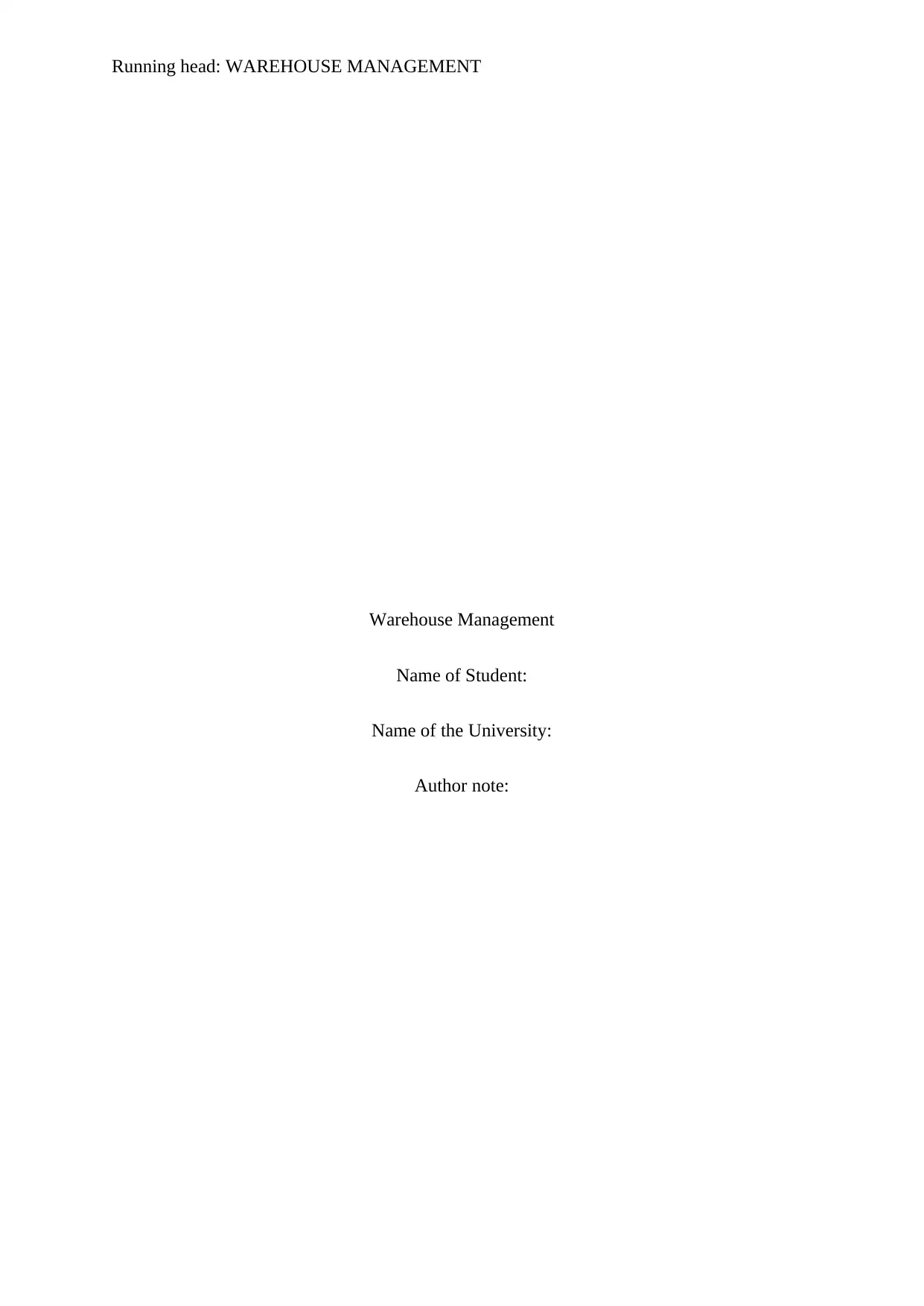
Running head: WAREHOUSE MANAGEMENT
Warehouse Management
Name of Student:
Name of the University:
Author note:
Warehouse Management
Name of Student:
Name of the University:
Author note:
Paraphrase This Document
Need a fresh take? Get an instant paraphrase of this document with our AI Paraphraser
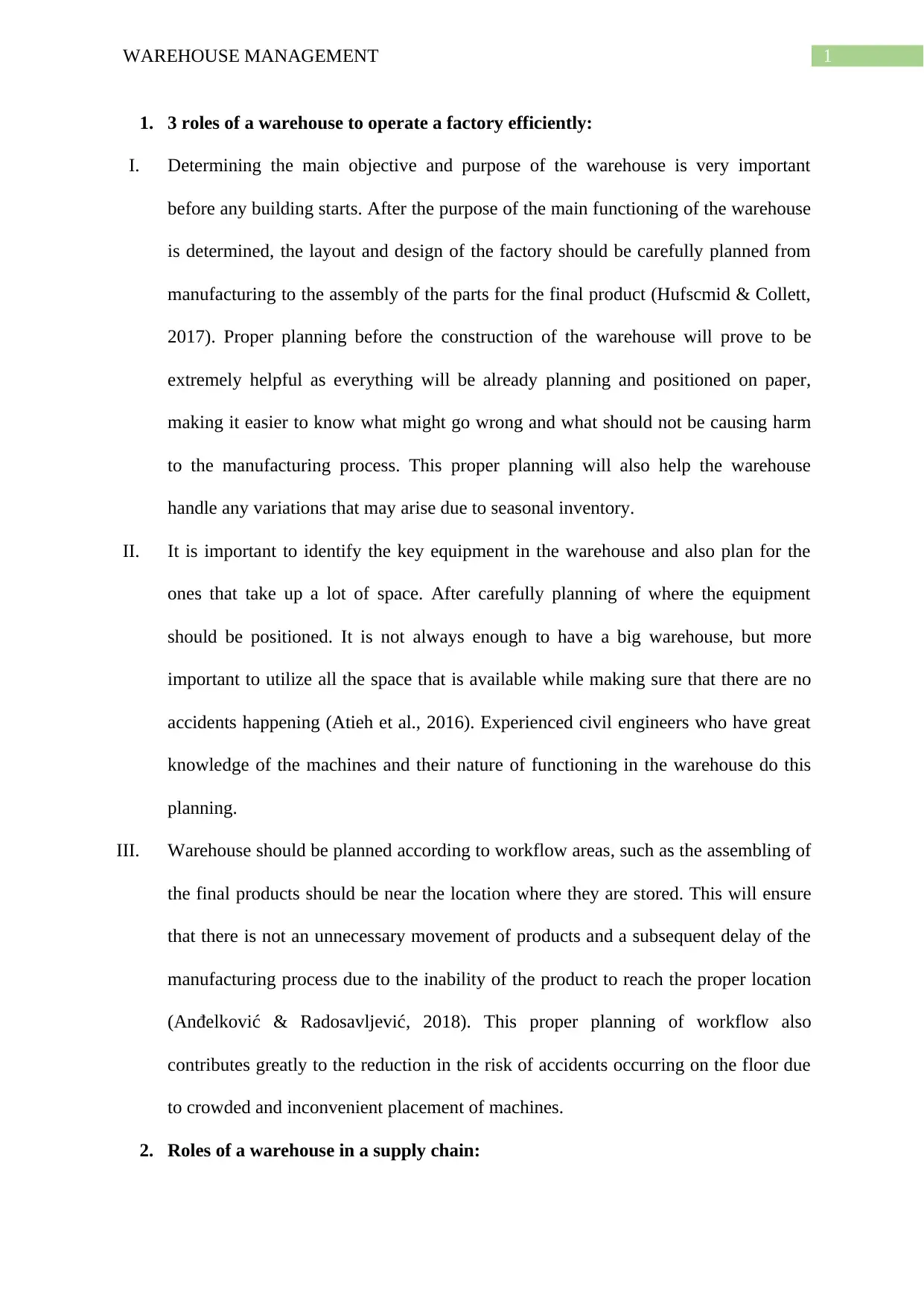
1WAREHOUSE MANAGEMENT
1. 3 roles of a warehouse to operate a factory efficiently:
I. Determining the main objective and purpose of the warehouse is very important
before any building starts. After the purpose of the main functioning of the warehouse
is determined, the layout and design of the factory should be carefully planned from
manufacturing to the assembly of the parts for the final product (Hufscmid & Collett,
2017). Proper planning before the construction of the warehouse will prove to be
extremely helpful as everything will be already planning and positioned on paper,
making it easier to know what might go wrong and what should not be causing harm
to the manufacturing process. This proper planning will also help the warehouse
handle any variations that may arise due to seasonal inventory.
II. It is important to identify the key equipment in the warehouse and also plan for the
ones that take up a lot of space. After carefully planning of where the equipment
should be positioned. It is not always enough to have a big warehouse, but more
important to utilize all the space that is available while making sure that there are no
accidents happening (Atieh et al., 2016). Experienced civil engineers who have great
knowledge of the machines and their nature of functioning in the warehouse do this
planning.
III. Warehouse should be planned according to workflow areas, such as the assembling of
the final products should be near the location where they are stored. This will ensure
that there is not an unnecessary movement of products and a subsequent delay of the
manufacturing process due to the inability of the product to reach the proper location
(Anđelković & Radosavljević, 2018). This proper planning of workflow also
contributes greatly to the reduction in the risk of accidents occurring on the floor due
to crowded and inconvenient placement of machines.
2. Roles of a warehouse in a supply chain:
1. 3 roles of a warehouse to operate a factory efficiently:
I. Determining the main objective and purpose of the warehouse is very important
before any building starts. After the purpose of the main functioning of the warehouse
is determined, the layout and design of the factory should be carefully planned from
manufacturing to the assembly of the parts for the final product (Hufscmid & Collett,
2017). Proper planning before the construction of the warehouse will prove to be
extremely helpful as everything will be already planning and positioned on paper,
making it easier to know what might go wrong and what should not be causing harm
to the manufacturing process. This proper planning will also help the warehouse
handle any variations that may arise due to seasonal inventory.
II. It is important to identify the key equipment in the warehouse and also plan for the
ones that take up a lot of space. After carefully planning of where the equipment
should be positioned. It is not always enough to have a big warehouse, but more
important to utilize all the space that is available while making sure that there are no
accidents happening (Atieh et al., 2016). Experienced civil engineers who have great
knowledge of the machines and their nature of functioning in the warehouse do this
planning.
III. Warehouse should be planned according to workflow areas, such as the assembling of
the final products should be near the location where they are stored. This will ensure
that there is not an unnecessary movement of products and a subsequent delay of the
manufacturing process due to the inability of the product to reach the proper location
(Anđelković & Radosavljević, 2018). This proper planning of workflow also
contributes greatly to the reduction in the risk of accidents occurring on the floor due
to crowded and inconvenient placement of machines.
2. Roles of a warehouse in a supply chain:
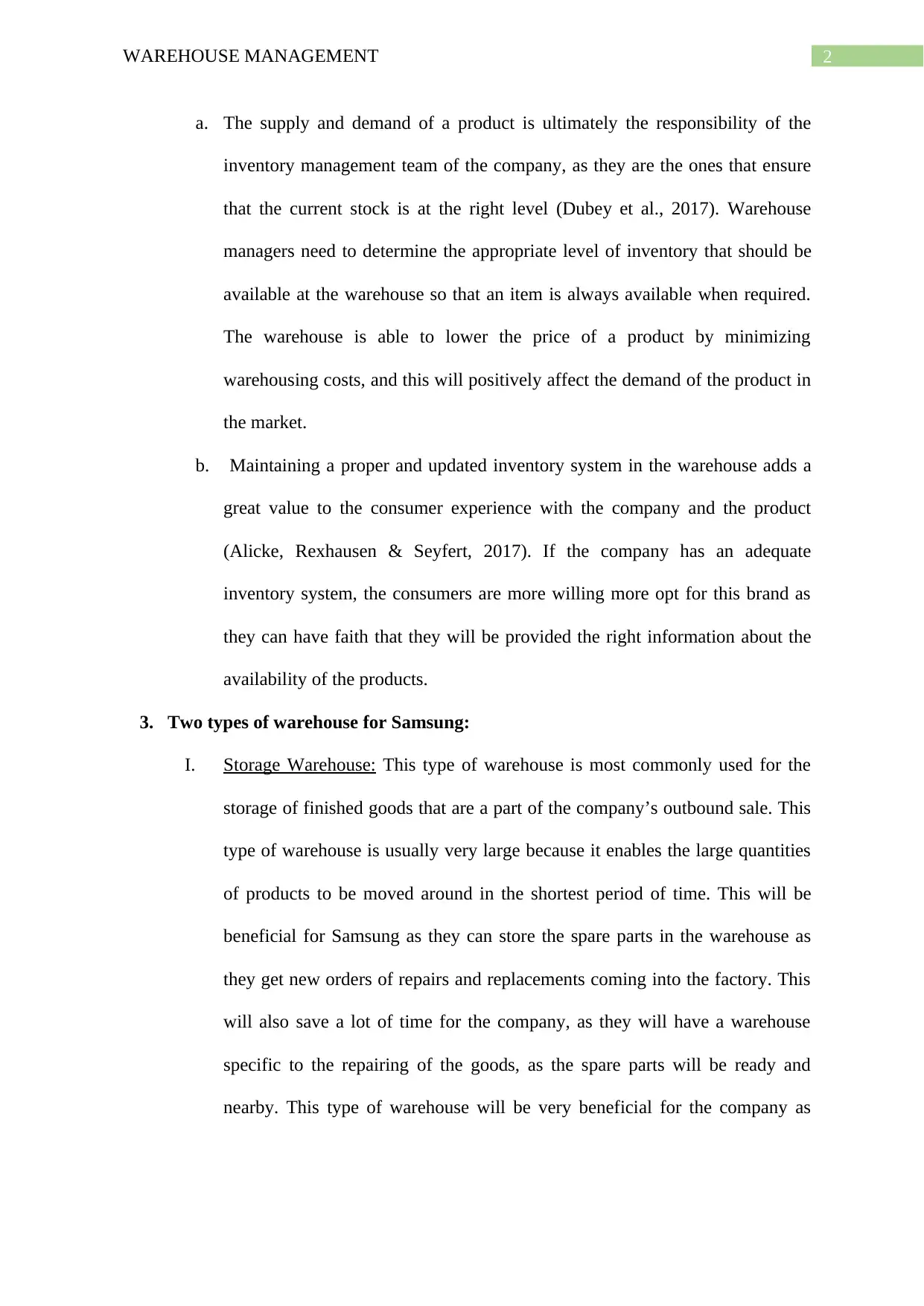
2WAREHOUSE MANAGEMENT
a. The supply and demand of a product is ultimately the responsibility of the
inventory management team of the company, as they are the ones that ensure
that the current stock is at the right level (Dubey et al., 2017). Warehouse
managers need to determine the appropriate level of inventory that should be
available at the warehouse so that an item is always available when required.
The warehouse is able to lower the price of a product by minimizing
warehousing costs, and this will positively affect the demand of the product in
the market.
b. Maintaining a proper and updated inventory system in the warehouse adds a
great value to the consumer experience with the company and the product
(Alicke, Rexhausen & Seyfert, 2017). If the company has an adequate
inventory system, the consumers are more willing more opt for this brand as
they can have faith that they will be provided the right information about the
availability of the products.
3. Two types of warehouse for Samsung:
I. Storage Warehouse: This type of warehouse is most commonly used for the
storage of finished goods that are a part of the company’s outbound sale. This
type of warehouse is usually very large because it enables the large quantities
of products to be moved around in the shortest period of time. This will be
beneficial for Samsung as they can store the spare parts in the warehouse as
they get new orders of repairs and replacements coming into the factory. This
will also save a lot of time for the company, as they will have a warehouse
specific to the repairing of the goods, as the spare parts will be ready and
nearby. This type of warehouse will be very beneficial for the company as
a. The supply and demand of a product is ultimately the responsibility of the
inventory management team of the company, as they are the ones that ensure
that the current stock is at the right level (Dubey et al., 2017). Warehouse
managers need to determine the appropriate level of inventory that should be
available at the warehouse so that an item is always available when required.
The warehouse is able to lower the price of a product by minimizing
warehousing costs, and this will positively affect the demand of the product in
the market.
b. Maintaining a proper and updated inventory system in the warehouse adds a
great value to the consumer experience with the company and the product
(Alicke, Rexhausen & Seyfert, 2017). If the company has an adequate
inventory system, the consumers are more willing more opt for this brand as
they can have faith that they will be provided the right information about the
availability of the products.
3. Two types of warehouse for Samsung:
I. Storage Warehouse: This type of warehouse is most commonly used for the
storage of finished goods that are a part of the company’s outbound sale. This
type of warehouse is usually very large because it enables the large quantities
of products to be moved around in the shortest period of time. This will be
beneficial for Samsung as they can store the spare parts in the warehouse as
they get new orders of repairs and replacements coming into the factory. This
will also save a lot of time for the company, as they will have a warehouse
specific to the repairing of the goods, as the spare parts will be ready and
nearby. This type of warehouse will be very beneficial for the company as
⊘ This is a preview!⊘
Do you want full access?
Subscribe today to unlock all pages.

Trusted by 1+ million students worldwide
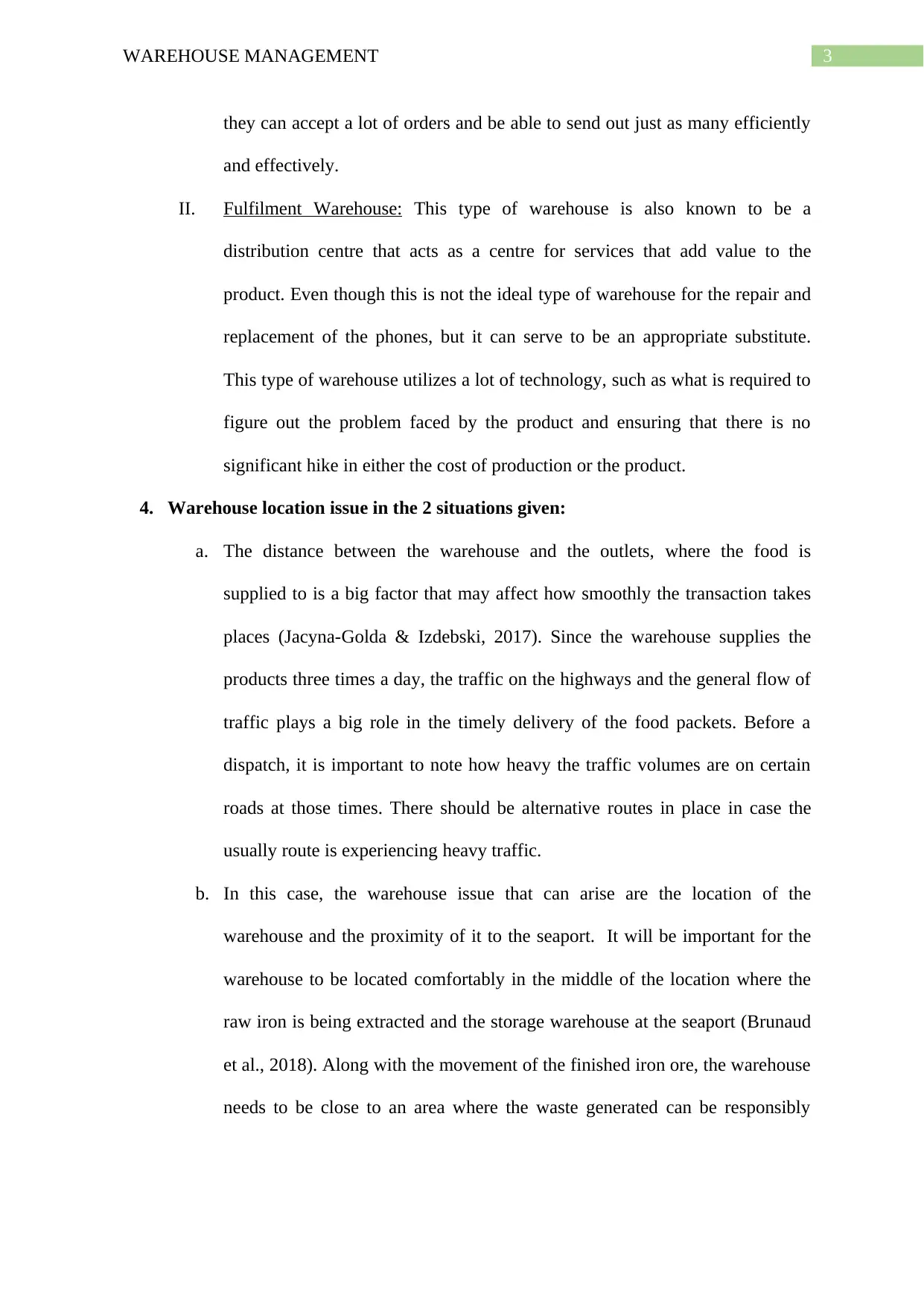
3WAREHOUSE MANAGEMENT
they can accept a lot of orders and be able to send out just as many efficiently
and effectively.
II. Fulfilment Warehouse: This type of warehouse is also known to be a
distribution centre that acts as a centre for services that add value to the
product. Even though this is not the ideal type of warehouse for the repair and
replacement of the phones, but it can serve to be an appropriate substitute.
This type of warehouse utilizes a lot of technology, such as what is required to
figure out the problem faced by the product and ensuring that there is no
significant hike in either the cost of production or the product.
4. Warehouse location issue in the 2 situations given:
a. The distance between the warehouse and the outlets, where the food is
supplied to is a big factor that may affect how smoothly the transaction takes
places (Jacyna-Golda & Izdebski, 2017). Since the warehouse supplies the
products three times a day, the traffic on the highways and the general flow of
traffic plays a big role in the timely delivery of the food packets. Before a
dispatch, it is important to note how heavy the traffic volumes are on certain
roads at those times. There should be alternative routes in place in case the
usually route is experiencing heavy traffic.
b. In this case, the warehouse issue that can arise are the location of the
warehouse and the proximity of it to the seaport. It will be important for the
warehouse to be located comfortably in the middle of the location where the
raw iron is being extracted and the storage warehouse at the seaport (Brunaud
et al., 2018). Along with the movement of the finished iron ore, the warehouse
needs to be close to an area where the waste generated can be responsibly
they can accept a lot of orders and be able to send out just as many efficiently
and effectively.
II. Fulfilment Warehouse: This type of warehouse is also known to be a
distribution centre that acts as a centre for services that add value to the
product. Even though this is not the ideal type of warehouse for the repair and
replacement of the phones, but it can serve to be an appropriate substitute.
This type of warehouse utilizes a lot of technology, such as what is required to
figure out the problem faced by the product and ensuring that there is no
significant hike in either the cost of production or the product.
4. Warehouse location issue in the 2 situations given:
a. The distance between the warehouse and the outlets, where the food is
supplied to is a big factor that may affect how smoothly the transaction takes
places (Jacyna-Golda & Izdebski, 2017). Since the warehouse supplies the
products three times a day, the traffic on the highways and the general flow of
traffic plays a big role in the timely delivery of the food packets. Before a
dispatch, it is important to note how heavy the traffic volumes are on certain
roads at those times. There should be alternative routes in place in case the
usually route is experiencing heavy traffic.
b. In this case, the warehouse issue that can arise are the location of the
warehouse and the proximity of it to the seaport. It will be important for the
warehouse to be located comfortably in the middle of the location where the
raw iron is being extracted and the storage warehouse at the seaport (Brunaud
et al., 2018). Along with the movement of the finished iron ore, the warehouse
needs to be close to an area where the waste generated can be responsibly
Paraphrase This Document
Need a fresh take? Get an instant paraphrase of this document with our AI Paraphraser

4WAREHOUSE MANAGEMENT
dumped. Along with location, the relative size of the warehouse in terms of
holding capacity is also an important factor.
dumped. Along with location, the relative size of the warehouse in terms of
holding capacity is also an important factor.
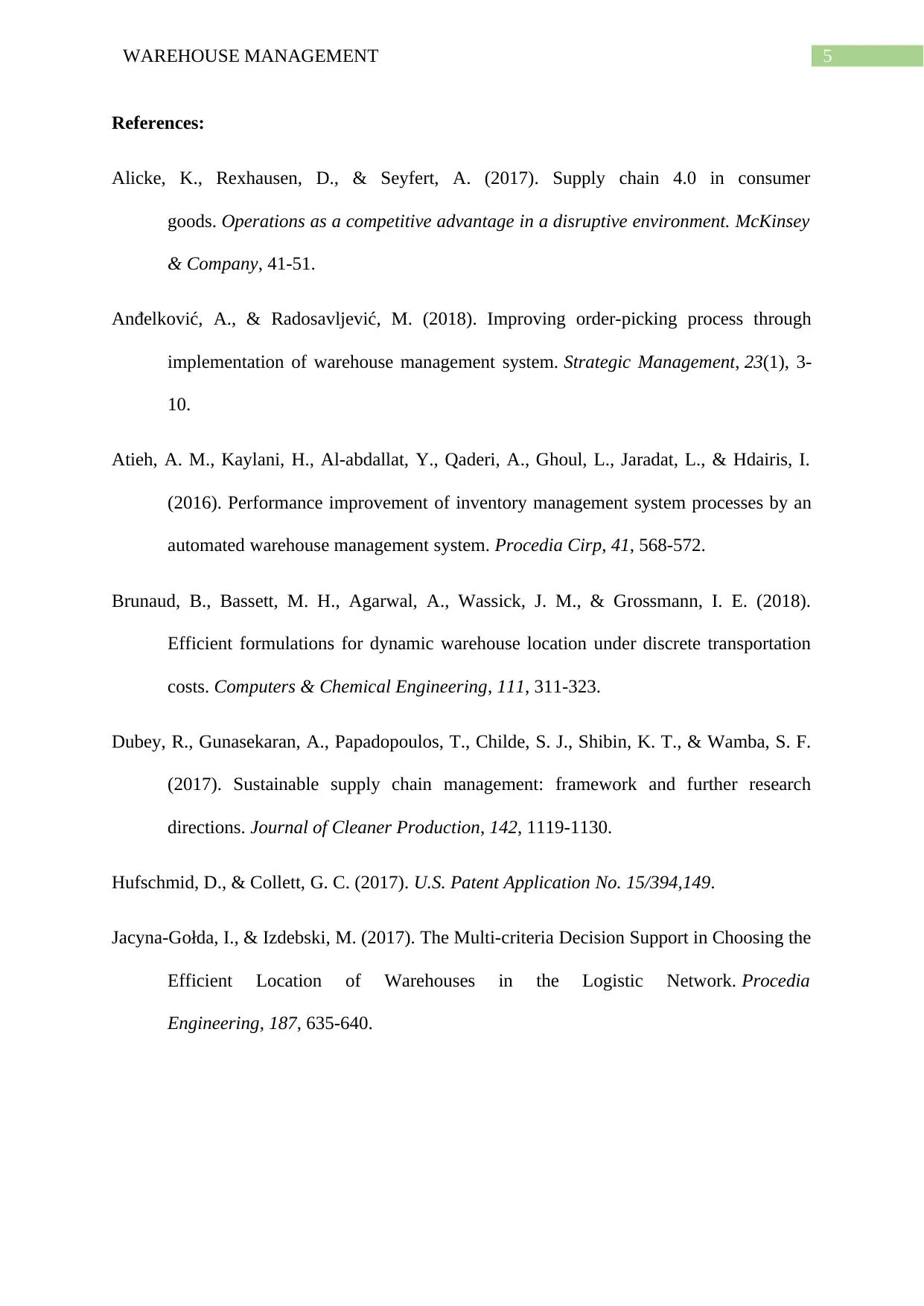
5WAREHOUSE MANAGEMENT
References:
Alicke, K., Rexhausen, D., & Seyfert, A. (2017). Supply chain 4.0 in consumer
goods. Operations as a competitive advantage in a disruptive environment. McKinsey
& Company, 41-51.
Anđelković, A., & Radosavljević, M. (2018). Improving order-picking process through
implementation of warehouse management system. Strategic Management, 23(1), 3-
10.
Atieh, A. M., Kaylani, H., Al-abdallat, Y., Qaderi, A., Ghoul, L., Jaradat, L., & Hdairis, I.
(2016). Performance improvement of inventory management system processes by an
automated warehouse management system. Procedia Cirp, 41, 568-572.
Brunaud, B., Bassett, M. H., Agarwal, A., Wassick, J. M., & Grossmann, I. E. (2018).
Efficient formulations for dynamic warehouse location under discrete transportation
costs. Computers & Chemical Engineering, 111, 311-323.
Dubey, R., Gunasekaran, A., Papadopoulos, T., Childe, S. J., Shibin, K. T., & Wamba, S. F.
(2017). Sustainable supply chain management: framework and further research
directions. Journal of Cleaner Production, 142, 1119-1130.
Hufschmid, D., & Collett, G. C. (2017). U.S. Patent Application No. 15/394,149.
Jacyna-Gołda, I., & Izdebski, M. (2017). The Multi-criteria Decision Support in Choosing the
Efficient Location of Warehouses in the Logistic Network. Procedia
Engineering, 187, 635-640.
References:
Alicke, K., Rexhausen, D., & Seyfert, A. (2017). Supply chain 4.0 in consumer
goods. Operations as a competitive advantage in a disruptive environment. McKinsey
& Company, 41-51.
Anđelković, A., & Radosavljević, M. (2018). Improving order-picking process through
implementation of warehouse management system. Strategic Management, 23(1), 3-
10.
Atieh, A. M., Kaylani, H., Al-abdallat, Y., Qaderi, A., Ghoul, L., Jaradat, L., & Hdairis, I.
(2016). Performance improvement of inventory management system processes by an
automated warehouse management system. Procedia Cirp, 41, 568-572.
Brunaud, B., Bassett, M. H., Agarwal, A., Wassick, J. M., & Grossmann, I. E. (2018).
Efficient formulations for dynamic warehouse location under discrete transportation
costs. Computers & Chemical Engineering, 111, 311-323.
Dubey, R., Gunasekaran, A., Papadopoulos, T., Childe, S. J., Shibin, K. T., & Wamba, S. F.
(2017). Sustainable supply chain management: framework and further research
directions. Journal of Cleaner Production, 142, 1119-1130.
Hufschmid, D., & Collett, G. C. (2017). U.S. Patent Application No. 15/394,149.
Jacyna-Gołda, I., & Izdebski, M. (2017). The Multi-criteria Decision Support in Choosing the
Efficient Location of Warehouses in the Logistic Network. Procedia
Engineering, 187, 635-640.
⊘ This is a preview!⊘
Do you want full access?
Subscribe today to unlock all pages.

Trusted by 1+ million students worldwide
1 out of 6
Related Documents
Your All-in-One AI-Powered Toolkit for Academic Success.
+13062052269
info@desklib.com
Available 24*7 on WhatsApp / Email
![[object Object]](/_next/static/media/star-bottom.7253800d.svg)
Unlock your academic potential
Copyright © 2020–2025 A2Z Services. All Rights Reserved. Developed and managed by ZUCOL.




